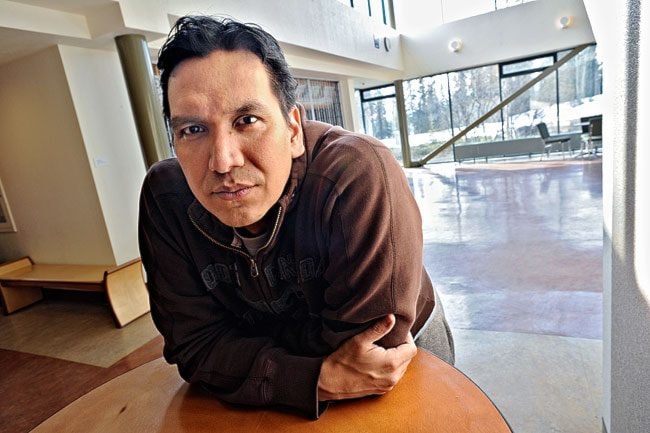When the curtain falls on Nakai’s newest play The River, Michael Greyeyes will be happy if no one claps.
“My re-engineering of the audiences’ perspective is: we’re gathered for an event,” said the director. “It’s not a show, it’s not a play or a theatre event. It’s a communal gathering to hear what we shouldn’t have ignored.
“It’s unsettling for the audience, and that’s the point.”
Greyeyes was called to the piece by fellow York University colleague Judith Rudakoff.
Rudakoff, together with David Skelton and Joseph Tisiga, wrote a play that looks at the lives of people living on the fringe.
“The play is inspired by the notion of ghost populations,” she said. “Ghost populations are everything from homeless people to alien abductees
- it’s a term used by the Canadian government for people who don’t have a fixed address. So it could be a tourist, an itinerant worker. We’re looking at invisible populations in Whitehorse who are there, they’re just not seen.”
The writing trio spent numerous hours at Whitehorse’s Salvation Army, speaking to people but not stealing from them, said Rudakoff.
“It’s not based on anyone’s life,” she said. “That would be appropriating their stories and we feel their stories are their own to tell.”
Many of the people at the shelter did inspire the work however and the play is dedicated to them, said Rudakoff.
But it is not only about homelessness or poverty, Greyeyes stresses.
“It’s about voicelessness,” he said. “And there’s no borders.”
There are a total of 12 characters, but only five actors.
Among others, there is a homeless character, an elderly tourist, a drifter, an alien abductee, a missing girl who may be dead, and a new high school graduate who can’t find his missing girlfriend and sits on the cusp of this marginalized world.
“People are not who they seem,” said Rudakoff.
And nothing about the play is traditional, said Greyeyes, adding there are aboriginal actors playing non-aboriginal people.
So his main task is to make things clear, he said.
The renowned actor, dancer, director and choreographer attempts to achieve this largely through stage direction and movement, he said.
Certain characters speak in a certain way surrounded by certain things, so when the same actor switches characters, that transition will be noticeable by their movement with those things, he explained.
But even if people are confused, Greyeyes is not concerned about losing the message.
“This play has no centralized message,” he said. “Each character has messages. It’s an experience.”
“I like to think of it like music,” said Skelton. “With music you can’t go, ‘There’s the message.’ But it is emotionally moving.”
The set-up of the play isn’t exactly traditional either, said Rudakoff.
Almost the entire play consists of monologues.
“Each of these voices is isolated,” she said. “But they intersect like tributaries of the river. They are all apart of this one great current that runs through Whitehorse, but they each have their individual voices.”
And every voice has the right to be there, she said, even if they are not common characters in the world of theatre.
“Everybody has a story worth telling,” said Greyeyes. “What this play does is take voices and characters that don’t normally have a place on Canadian stages and says, ‘The stage is yours.’”
But it’s not political, he said.
“It’s completely humanistic,” he said. “Meaning, politics may be the result of things, but what it says is, every character in this play is compelling.”
The play will be a success if even just one audience member leaves able to empathize with someone they would normally dismiss, said Skelton.
But there won’t be any speeches, lectures or preaching in the play.
The way the script is written is very informal, said Skelton.
“It’s like sitting around a fire and shooting the shit,” he said. “And then for some reason, somebody starts to talk about something really important.”
The play will be performed at the Yukon Arts Centre studio space, which is a much smaller stage offering only about 30 seats.
“It’s very intimate,” he said. “You really see the creases and the sweat of the character. And you hear the small noises and the little winces. The detail in smaller spaces is much greater.”
The play is also about one hour and 25 minutes long, with no intermission.
But it goes quick, said Skelton, explaining that it is broken up into 63 short scenes.
And despite the heavy content, the audience will be able to laugh, said Rudakoff - which is a message the people at the Salvation Army, who spoke to the writers, really stressed.
“We read portions of an earlier draft to some of the folks at the Salvation Army’s warming room, cause they’re a tough audience, and they thought it was hilarious,” she said. “And they thanked us for making it funny because they said too often people think it’s always doom and gloom.”
The show is being produced in partnership with the Yukon Anti-Poverty Coalition and there are hopes to tour across the territory and, eventually, Canada.
There will also be a special show at the Salvation Army.
Opening night at the Yukon Arts Centre is this Friday, April 22 at 7:30 p.m.
The River will runs Tuesday through Saturday until May 1.
The April 28 show is at the Salvation Army and is by invitation only.
There are matinees April 29, 30 and only a matinee on May 1.
Contact Roxanne Stasyszyn at
roxannes@yukon-news.com
